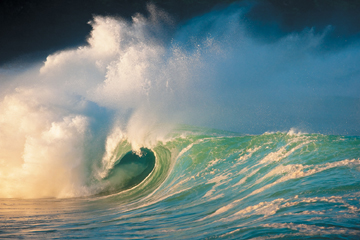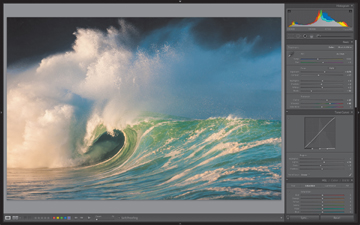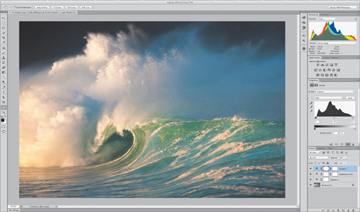The Wave
For several days in a row, while shooting surfing on the north shore of Oahu, I got up before dawn to shoot “empty” wave images at Waimea Bay (Figure 5.7). As someone who isn’t a surfer and who hasn’t shot surfing for that long, I found this exercise less than exhilarating. After all, I thought, they are just waves. But my buddy Brian Bielmann, the aforementioned “godfather” of surfing photography, was heading out each morning to shoot open waves, and I tagged along each time, not only because the light was great, but also because Brian had shown me some incredible images of waves exploding in the bay. After a few mornings, I started to get it. Even without a surfer on the wave, there were majestic split-second moments where the wave would curl over and explode 30 or 40 feet into the air. It took keen concentration and a quick trigger finger to capture them, and little did I know that I would create an award-winning image of a wave.

Figure 5.7. A wave exploding in Waimea Bay on the north shore of Oahu, Hawaii, the morning of the 2009/2010 Quiksilver In Memory of Eddie Aikau big wave surfing competition.
Nikon D700, Nikon 500mm f/4.0 lens, ISO 400, 1/2000th second at f/5.6
The Story
The morning this shot was made, I found myself standing next to practically every big name surfing photographer on the planet. Everyone who was anyone in the surfing world had flown in a few days earlier in anticipation of the Eddie Aikau surfing competition, and as the swell continued to rise, the waves in Waimea Bay became larger and larger. Every morning like clockwork, before and after the Eddie, photographers swarmed to the bay to shoot images of empty waves. This image was shot the morning before the Eddie Aikau big wave surfing competition started. There were upwards of 70,000 people either on route or already camped out at the bay waiting to hear whether the contest was a go or not. Because traffic was in such a snarl, we arrived at 4:30 a.m. to claim our spot on the guardrail, which is the best vantage point for shooting empty waves.
Even without a surfer on the wave, there were majestic split-second moments where the wave would curl over and explode 30 or 40 feet into the air.
The weather on this morning dawned crisp and clear. At 6:40 a.m. a shaft of light hit the waves breaking in the bay, and that was the exact moment this image was shot. As you can see in the image, the foreground is just starting to become illuminated, whereas the main part of the wave is fully illuminated, giving the wave a more dramatic feel. The difficulty of shooting breaking waves like this, and surfing in general, is that you never know exactly what is going to happen. As a result, you have to shoot a lot of images. On this morning I shot over 500 images of empty waves before the contest began. On the entire trip I shot well over 2,500 images of empty waves and a total of over 8,000 images. The reason: If you aren’t already shooting when the wave forms and explodes, you’ll miss the shot. Hence, to get the shot, you end up shooting almost every wave that rolls into the bay because you just never know what you’re going to get. At eight frames per second, that adds up to a lot of images very quickly. Every once in a while you get a few shots of a wave like this one or even better.
That morning I shot at least two dozen equally amazing images of open waves, but this image in particular seems to capture more attention than the rest. In fact, this image has won an honorable mention in the 2011 PDN’s (Photo District News) Great Outdoors Photography Competition, one of the biggest competitions anywhere for professional and amateur outdoor photographers. I was quite surprised because I thought some of the other images I submitted were stronger images. But that only goes to show how magical images of waves can be. Not surprisingly, several photographers who specialize in shooting empty waves make quite a good living selling their images as fine art prints. The ocean is a magical place, and capturing a moment when the ocean is going wild is just as appealing as a majestic mountain in a wild storm, if not more so.
The Gear
Equipment-wise, this image didn’t involve too much fancy footwork. I basically mounted a big lens on a fast camera and let it rip. This image was shot with a 500mm f/4 Nikkor lens on a Nikon D700, and both were mounted on a sturdy Gitzo tripod. Attached to the D700 was the MB-D10 battery grip, which allowed me to shoot at 8 frames per second (fps). Because the light was changing so quickly that day and especially right when this shot was taken at dawn, I had the camera in Aperture Priority auto-exposure mode so that it could automatically adjust the exposure. I set the exposure compensation to negative two-thirds of a stop because as the waves exploded into whitewater, the scene became significantly brighter and I didn’t want to blow out any key highlights in the final image. It was only by checking the Histogram on waves I shot earlier that morning that I figured out just how much exposure compensation to subtract from the automatic exposure.
The key to getting good images of waves is to anticipate when and where they will form, which isn’t easy. The only way to really get these images is to follow the wave into the bay, start blasting away at the highest framing rate your camera allows (in this case 8 fps), and hope the action happens with the shutter button depressed. One of the other concerns is the camera buffer, because you only get so many shots in a burst before the camera has to stop and write the images to the memory card. Hence, you have to choose the right moment to start firing, or you’ll miss the height of the action. Even if you don’t miss it, you might miss the next wave while the camera is emptying the buffer. In this case, as with a lot of sports photography, having a top-end camera with a huge buffer and a wicked fast lens with amazing auto focus is a major advantage.
Oddly enough, the biggest impediment to getting good images in a scenario like this is staying focused.
Oddly enough, the biggest impediment to getting good images in a scenario like this is staying focused. With so many other photographers standing right next to you, it is hard to concentrate and not get caught up in conversation. Whether it is waiting for your camera’s buffer to clear or cleaning the ocean spray off the front of your lens, there are plenty of opportunities to miss the shot. Regardless, as in this case, the early bird gets the worm. If you aren’t out there shooting, you’ll never get the shot.
The Postproduction
This image only needed very slight modifications to the raw image. In Lightroom I adjusted the overall brightness of the image using the Exposure slider (Figure 5.8), which was set to +0.70. The Highlights, Shadows, Whites, and Blacks sliders were set to +3, -2, +2, and -52, respectively. I left the White Balance as shot in the camera, and pushed the Clarity slider to +25 and the Vibrance slider to +40. The only other changes I made in Lightroom were to adjust the Lights and Darks sliders in the Tone Curve panel to +10 and -7, respectively, and to add two Graduated Filters, one on the left edge of the image and the other on the bottom of the image. These were added to keep the bright highlights of the whitewater from blowing out and to add a bit more drama to the shadowy bottom part of the image. Both Graduated Filters were adjusted using the Exposure slider. The lower Gradient was set to -0.42, and the left gradient was set to –0.52.

Figure 5.8. The raw image as it was processed in Lightroom.
In Photoshop I added my standard adjustment layers: a Levels adjustment, a Brightness/Contrast adjustment, and a Vibrance adjustment (Figure 5.9). I also added a layer mask to the Levels adjustment and also to the Brightness/Contrast adjustment to keep the highlights from blowing out in some of the exploding whitewater. The Levels sliders where set to 9 (black), 1.00 (middle), and 239 (white), and the Output Levels were set at 3 and 252. In the Brightness/Contrast adjustment layer I pulled the Brightness out to +2. In the Vibrance adjustment layer I set the Vibrance slider to +34 and the Saturation to +9.

Figure 5.9. The image as it was processed in Photoshop using a Levels adjustment layer (with a layer mask), a Brightness/Contrast adjustment layer (with a layer mask), and a Vibrance adjustment layer.
All of the adjustments were basically fine-tuning the Histogram and adding contrast and saturation to the image. The Lightroom Graduated Filters were added to help control the highlights and also to direct viewers’ attention to the part of the image that I wanted them to look at, which in this case is the curl of the wave. This is perhaps the greatest attribute of the Lightroom Graduated Filters. I use these Graduated Filters to help point viewers’ eyes to where I want them to go in the image, which is an incredibly powerful tool.